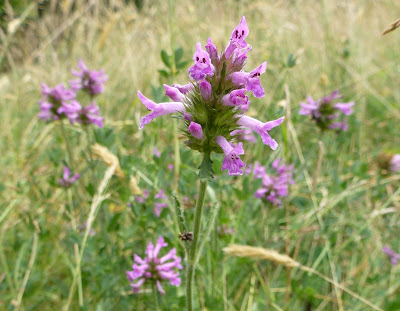Today’s
gathering was to meet Mervin and Denise, on holiday in the Broads, providing an
excuse for seven local Honeyguiders to visit Norfolk Wildlife Trust’s Hickling
Broad and Marshes. It was the final day of a heatwave, which was good for seeing
butterflies and dragonflies, though the heat was less severe here close to the
east coast.
 |
| Rutpela maculata, spotted longhorn. |
Even
the grassy picnic area by the reserve’s visitor centre seemed alive with butterflies,
such as small skippers, and dragonflies, the first common darters of the year
for me. Then in the corner where the walk onto the reserve starts there were more still, especially
three white admiral butterflies around the last few remaining bramble flowers, plus
a spotted longhorn beetle. With these were ringlets, commas and other commoner
butterflies. Then there was a good view of a four-spotted chaser on the right and
a Norfolk hawker on the left.
Warden
John Blackburn and two of his team passed us, saying; “Hello, just been moving
the Koniks.” And from Cadbury Hide there they were, four of these hardy horses,
first brought to Suffolk from Poland by the late Derek Moore in the 1990s,
initially to Suffolk Wildlife Trust’s Redgrave & Lopham Fen nature reserve,
and now a feature of conservation grazing work on many East Anglian wetlands.
 |
| Koniks at Hickling nature reserve, from Cadbury Hide. |
In
the reedbeds we heard bearded tits and a late season sedge warbler, and we both
heard and saw reed buntings and reed warblers. We paused by the padlocked gate
behind which is a regular spot for the rare fen mason wasp. They were probably
there, but they were a bit too far away for us to be sure. Ann was alert to the
ID of a close dragonfly: a ruddy darter, with black legs, though less ruddy in
colour this early in their season than later.
 |
| Ruddy darter. |
We
overlooked Hickling Broad where, as everywhere, there were marsh harriers and
one of several fast-flying swallowtail butterflies that we saw this morning.
Then into the shade of oak trees and downy birches where, given Merv’s
expertise, we looked for galls. There were oak apples, the first signs of tiny
spangle galls and a new one for me, the swollen lumps caused by the gall wasp Andricus
curvator.
 |
| Galls on oak caused by the gall wasp Andricus curvator. |
For
much of this time there were two more informal additions to our group, a mother
and daughter, the latter in Norfolk for a pond management course, happy to
share some of our findings and IDs. These included a brown hawker flying around the
area where later they took a boat trip. Then, at last, a swallowtail that wasn’t
flying at a vast rate of knots, though it wasn’t still enough for an easy
photo. Three great egrets flew over.
There
wasn’t much to see from Bittern Hide but just after we’d come out of the hide there
were three plastic posts that were plainly protecting something. In a bare
patch of ground, we watched fen mason wasps coming and going into holes, many
of which had distinctive ‘turrets’ of dry mud. The photos also show the
granola-like piles of soil pellets created by their digging.
 |
| Fen mason wasp collage. |
There
were six little egrets, some lapwings and a single shoveler on Brendan’s Marsh.
Then it was time to head back to the visitor centre area where, luckily, a
picnic bench in the shade was free. |
| Gatekeeper. |
And
then there were four, as after packed lunches and ice creams several of the
group went onto other things, leaving Merv, Denise, Ann and me. I picked up the
telescope and we walked along the other side of Brendan’s Marsh. The number of
insects here was brilliant: among the butterflies, gatekeepers were especially numerous,
and blue-tailed damselflies (and others) seemed to like to perch on gorse. Merv
pointed out galls on both blackthorn and hawthorn leaves. On the viewing platforms
overlooking the marsh the wind was almost chilly – a strange sensation of late. |
| Blue-tailed damselflies. |
 |
| Blackthorn gall, cause by the gall mite Eriophyes similis. |
John
Blackburn had told me that he was not sure if Hickling’s spoonbills were nesting
for a third year: they are extraordinarily late in starting to nest and easily deterred
by stroppy herons in the heronry area. However, there is good news: two distant
white lumps in dead trees were apparently occupied nests of spoonbills, though
it took some patience before one moved enough to confirm its identity. |
| Cinnabar moth caterpillars on ragwort. |
We
continued the short distance to the Stubb Mill viewpoint from where there was,
predictably, little to see on a summer's day. Near here we found cinnabar moth caterpillars on ragwort
plants. It struck us how the caterpillars were on generally dry, isolated and
sometimes trampled plants. As we returned, there were lush patches of ragwort in
among reeds that you might imagine were much more attractive for a hungry caterpillar,
but apparently not.Chris Durdin






















